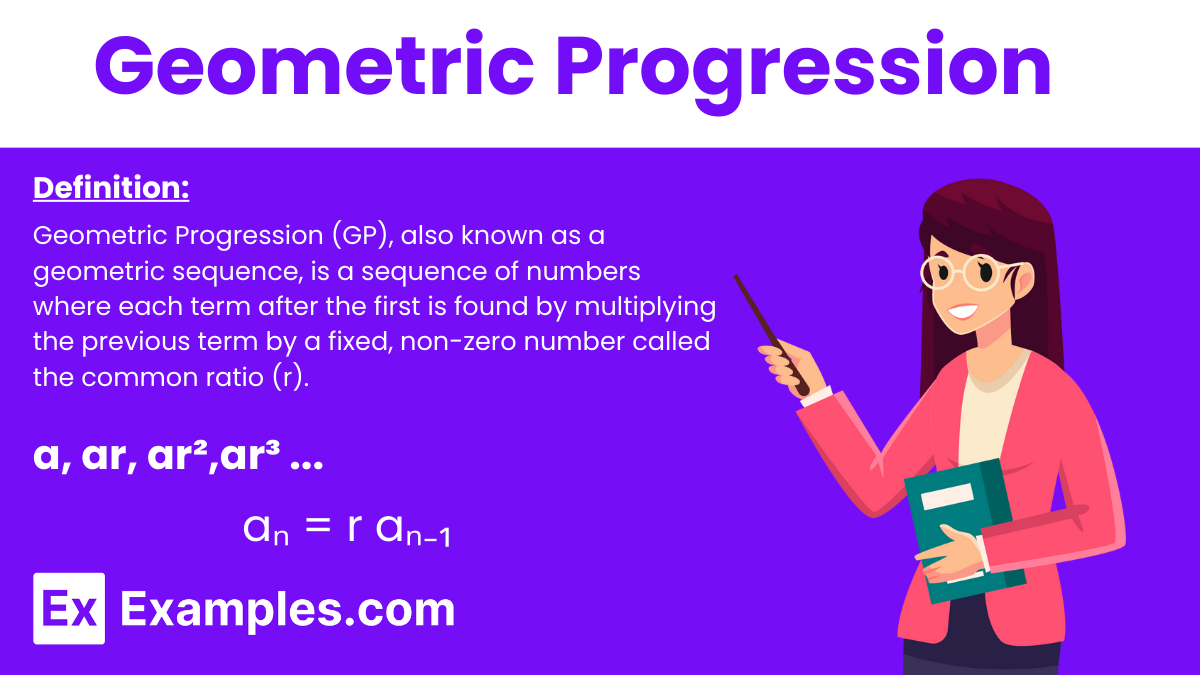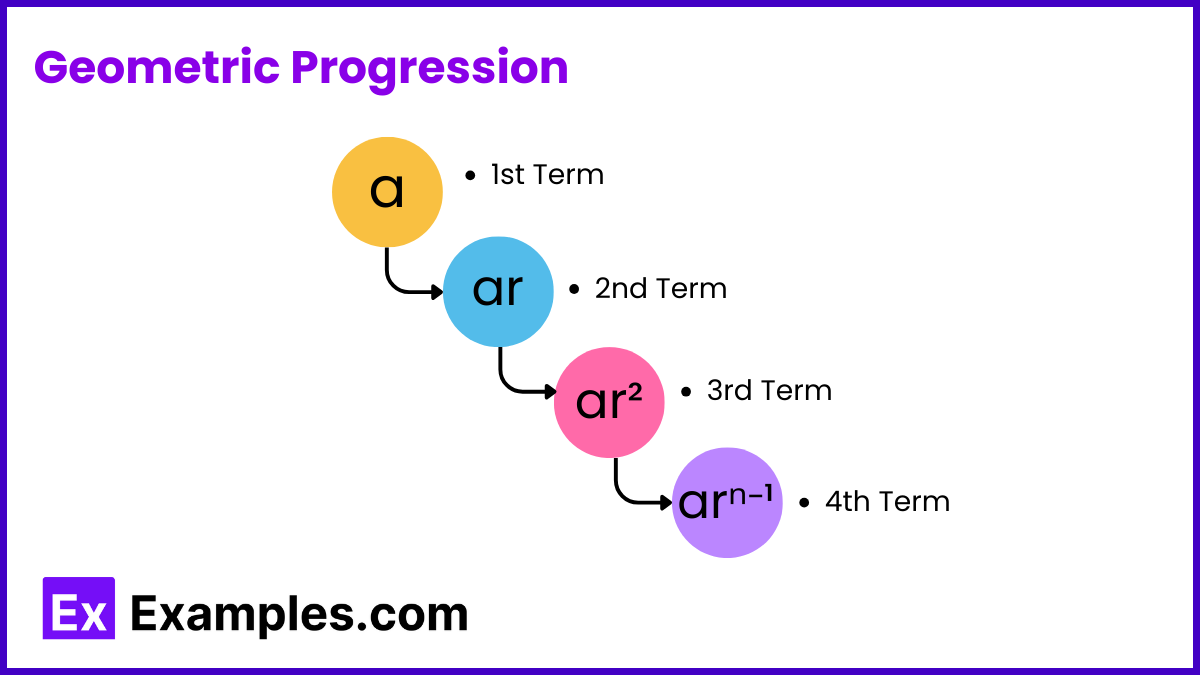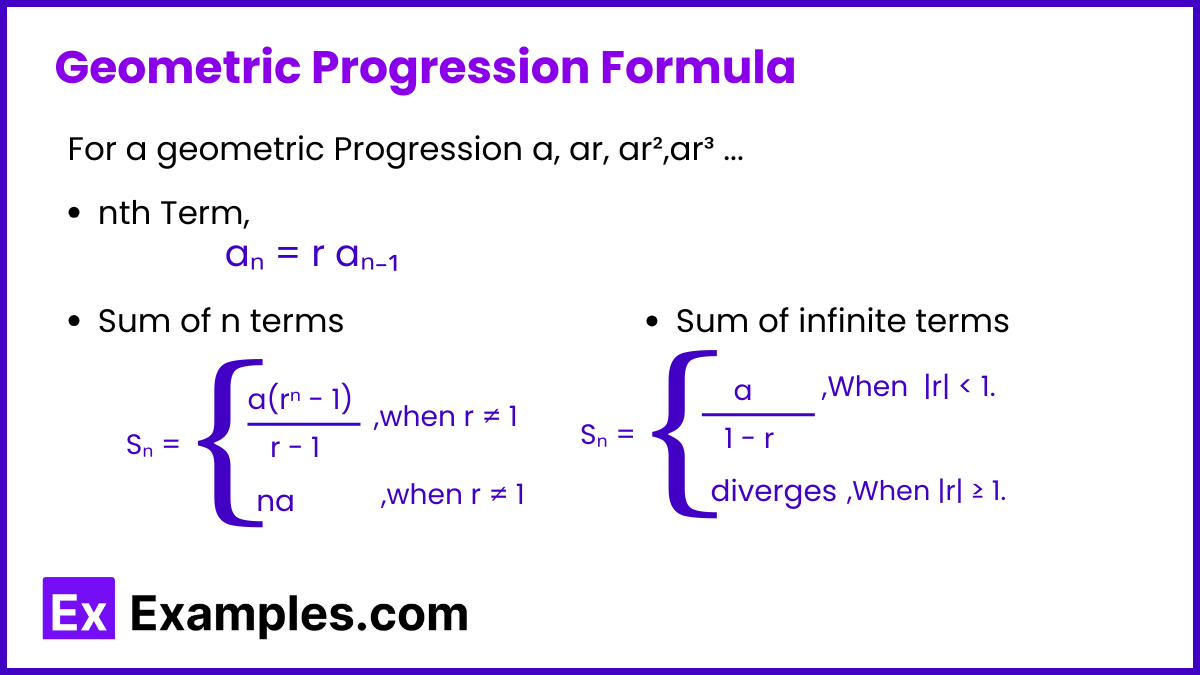What is the common ratio in the geometric sequence 3, 6, 12, 24?
2
3
4
6


Geometric Progression (GP), also known as a geometric sequence, is a sequence of numbers where each term after the first is found by multiplying the previous term by a fixed, non-zero number called the common ratio (r).

Geometric Progression (GP) is a sequence where each term is found by multiplying the previous one by a fixed number, known as the common ratio. It’s symbolized as ‘a, ar, ar²…’ where ‘a’ is the first term and ‘r’ is the common ratio. ‘r’ can be positive or negative. With just the first term and the ratio, you can determine all the terms of the sequence.

Here are the formulas related to geometric progressions, considering a sequence that begins with 𝑎a and follows the pattern a, ar, ar²,𝑎𝑟³….
Here are the important properties of Geometric Progression (GP) presented more succinctly:
he general form of a Geometric Progression (GP) is represented as:
𝑎,𝑎𝑟,𝑎𝑟²,𝑎𝑟³,𝑎𝑟⁴,…,𝑎𝑟ⁿ⁻¹
Where:
This formula encapsulates the pattern where each term is obtained by multiplying the previous term by the common ratio ‘r’.
Let a be the first term and r be the common ratio for a Geometric Sequence.
Then, the second term, a₂ = a × r = ar
Third term, a₃ = a₂ × r = ar × r = ar²
Similarly, nth term, aₙ = arⁿ⁻¹
Therefore, the formula to find the nth term of GP is:
| aₙ = tₙ = arⁿ⁻¹ |
Consider the sequence a, ar, ar², ar³,……
First term = a
Second term = ar
Third term = ar²
Similarly, nth term, tₙ = arⁿ⁻¹
Thus, the common ratio of geometric progression formula is given as:
Common ratio = (Any term) / (Preceding term)
= tₙ / tₙ₋₁
= (arⁿ⁻¹ ) /(arⁿ⁻²)
= r
Thus, the general term of a GP is given by ar and the general form of a GP is a, ar, ar2,…..
For Example: r = t₂ / t₁ = ar / a = r
uppose a, ar, ar², ar³,……arⁿ⁻¹ is the given Geometric Progression.
Then the sum of n terms of GP is given by:
Sn = a + ar + ar² + ar³ +…+ arⁿ⁻¹
The formula to find the sum of n terms of GP is:
| Sₙ = a[(rⁿ – 1)/(r – 1)] if r ≠ 1 and r > 1 |
Where
a is the first term
r is the common ratio
n is the number of terms
Also, if the common ratio is equal to 1, then the sum of the GP is given by:
| Sₙ = na if r = 1 |
| Aspect | Geometric Progression (GP) | Arithmetic Progression (AP) |
|---|---|---|
| Definition | A sequence where each term after the first is multiplied by a constant. | A sequence where each term after the first is added by a constant. |
| Common Term | Common Ratio (r) | Common Difference (d) |
| Formula | The nth term is given by 𝑎⋅𝑟(𝑛−1) | The nth term is given by 𝑎+(𝑛−1)⋅𝑑 |
| Example | 2, 6, 18, 54, … (where 𝑟=3) | 5, 8, 11, 14, … (where 𝑑=3) |
| Sum Formula | Sum of first n terms: 𝑆ₙ=𝑎⋅𝑟ⁿ⁻¹/𝑟−1(if 𝑟≠1) | Sum of first n terms: 𝑆ₙ=𝑛/2⋅(2𝑎+(𝑛−1)⋅𝑑) |
| Applications | Used in scenarios involving exponential growth or decay, such as populations, finance. | Used in evenly spaced contexts like scheduling, constructing sequences. |
The terms of a finite G.P. can be written as a, ar, ar², ar³,……arⁿ⁻¹
a, ar, ar², ar³,……arⁿ⁻¹ is called finite geometric series.
The sum of finite Geometric series is given by:
| Sn = a[(rⁿ – 1)/(r – 1)] if r ≠ 1 and r > 1 |
Geometric progressions (GPs) are a fundamental concept in mathematics with extensive applications across various fields such as finance, physics, and computer science. Here are some essential tips to help you understand and effectively work with geometric progressions:
The four terms of a geometric progression are 𝑎,𝑎𝑟,𝑎𝑟2,𝑎𝑟3, where a is the first term and r is the common ratio. Each term is obtained by multiplying the previous term by r.
The rule of geometric progression states that each term in the sequence is obtained by multiplying the previous term by a constant factor, known as the common ratio (𝑟r).
An example of geometric progression in real life is the growth of a population of bacteria. If each bacterium doubles every hour, the population follows a geometric progression, with the number of bacteria doubling with each generation.
Text prompt
Add Tone
10 Examples of Public speaking
20 Examples of Gas lighting
What is the common ratio in the geometric sequence 3, 6, 12, 24?
2
3
4
6
What is the 5th term of the geometric progression 5, 10, 20, 40?
80
120
160
200
If the first term of a geometric progression is 7 and the common ratio is 3, what is the 4th term?
21
63
189
567
What is the sum of the first 3 terms of the geometric progression 2, 6, 18?
24
26
28
30
If the sum of the first 4 terms of a geometric progression is 30 and the common ratio is 2, what is the first term?
2
3
4
5
What is the common ratio of a geometric progression if the 2nd term is 9 and the 4th term is 81?
1
2
3
4
If the 3rd term of a geometric progression is 16 and the common ratio is 4, what is the first term?
1
2
3
4
Find the 6th term of the geometric progression 1, 2, 4, 8.
16
32
64
120
If the first term of a geometric progression is 3 and the common ratio is 2, what is the sum of the first 4 terms?
24
30
45
60
What is the 7th term of the geometric progression 2, 6, 18, 54?
162
324
486
1458
Before you leave, take our quick quiz to enhance your learning!

